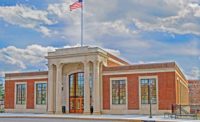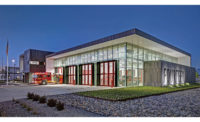Factoria Recycling and Transfer Station
Bellevue, Wash.
Best Project
Owner: King County Solid Waste Division
Lead Design Firms: J.R. Miller & Associates; HDR Engineering
General Contractor: PCL Construction Services Inc.
Civil/MEP Engineer: HDR Engineering
Structural Engineer: J.R. Miller & Associates
Owner’s Representative: Parametrix
All construction projects strive to combat waste—the waste of time, money and materials. But for the project team behind Bellevue’s new Factoria Recycling and Transfer Station, the fight against waste was personal.
The team found every possible opportunity to eliminate, recycle and divert construction waste when building the 78,248-sq-ft LEED Gold-pending facility that replaces an inefficient 50-plus-year-old transfer station.
“At the prior facility, all recyclable material was just thrown in with garbage, and it went to the landfill,” says Jeff Pietz, project manager at contractor PCL Construction Services. The new facility will divert approximately 5,000 tons of materials this year that would have been previously landfilled.
The $51.9-million project razed three buildings and built three more for waste and recycle transfer, administration and household hazardous waste. The team also built structural earth-wall retaining systems; soldier-pile and lagging shoring walls; 14 dewatering wells; extensive earthwork and underground utility work; 88,000 sq ft of concrete paving; 185,000 sq ft of asphalt paving; and extensive landscaping.
Sustainability guided all aspects of the project. The construction team achieved 95% waste diversion by salvaging temporary shoring and other building materials from the facility and pavement demolition. The pavement was recycled for use in new asphalt, and the concrete rubberized and used for embankments in other projects. “We spent a lot of time meeting with the owner, identifying every piece of the existing facility and hardscape that could be recycled,” Pietz says.
Scheduling was in four phases and meticulously sequenced so that service continued throughout construction. “Once the second phase was complete, the facility was operational, except for the recycling component, which wasn’t available until the third phase was complete,” Pietz says.
The completed building uses automated LED lighting, skylights and solar tubes. The toilets and facility washdown system uses reclaimed rainwater from 40,000-gallon tanks. Such features will save 1.3 million gallons of domestic water annually.





Post a comment to this article
Report Abusive Comment